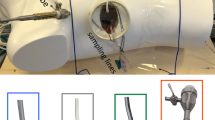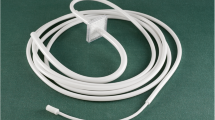Abstract
Purpose
Although the utility of the sitting position is undisputed for biomechanical and ergonomic reasons, it has been debated in recent years for its risks, particularly venous air embolism (VAE). In order to reduce the hemodynamic effect of VAE, we changed the composition of the surgical field air partially replacing nitrogen with carbon dioxide (CO2) that better dissolves in human tissues.
Methods
First, we tested our method on a test dummy in the sitting position. Infrared CO2 sensors were placed close to the wound opening and on the facial mask of the surgeon. An oxygen sensor was connected to a computer for data recording (ALTAIR®, MSA Safety). This model showed that 10 L/min CO2 flow provides efficient air displacement, maintaining safety for the surgeon. We reproduced the above-described surgical field environment in ten consecutive cases of posterior fossa surgery performed in the sitting position. A homogeneous group of ten patients operated in the sitting position with standard setting environment was used for control. We intraoperatively monitored VAE with trans-esophageal echocardiography (TEE), end-tidal CO2 (ETCO2), CO2 arterial pressure (PaCO2), and hemodynamic changes.
Results
Although the percentage of VAE was 70 % in both groups, hemodynamic effects occurred in 10 % of cases in the study group and in 40 % of cases in the control group.
Conclusions
Our preliminary study shows that a CO2-enriched sitting position surgical microenvironment significantly reduces the hemodynamic effects of VAE, more likely because arterial CO2 emboli are more soluble and consequently much better tolerated than air emboli.


Similar content being viewed by others
References
Bithal PK, Pandia MP, Dash HH, Chouhan RS, Mohanty B, Padhy N (2004) Comparative incidence of venous air embolism and associated hypotension in adults and children operated for neurosurgery in the sitting position. Eur J Anaesthesiol 21:517–522
Bruce JN (2012) Sitting position for the removal of pineal region lesions. World Neurosurg 77:657–658
Cunningham AJ, Hourihan D (2007) The sitting position in neurosurgery—unresolved hemodynamic consequences! Can J Anaesth 54:497–500
Dilmen OK, Akcil EF, Tureci E, Tunali Y, Bahar M, Tanriverdi T, Aydin S, Yentur E (2011) Neurosurgery in the sitting position: retrospective analysis of 692 adult and pediatric cases. Turk Neurosurg 21:634–640
Domaingue CM (2005) Neurosurgery in the sitting position: a case series. Anaesth Intensive Care 33:332–335
Ganslandt O, Merkel A, Schmitt H, Tzabazis A, Buchfelder M, Eyupoglu I, Muenster T (2013) The sitting position in neurosurgery: indications, complications and results. A single institution experience of 600 cases. Acta Neurochir (Wien) 155:1887–1893
Giebler R, Kollenberg B, Pohlen G, Peters J (1998) Effect of positive end-expiratory pressure on the incidence of venous air embolism and on the cardiovascular response to the sitting position during neurosurgery. Br J Anaesth 80:30–35
Jürgens S, Basu S (2014) The sitting position in anaesthesia: old and new. Eur J Anaesthesiol 31:285–287
Kaye AH, Leslie K (2012) The sitting position for neurosurgery: yet another case series confirming safety. World Neurosurg 77:42–43
Leslie K, Hui R, Kaye AH (2006) Venous air embolism and the sitting position: a case series. J Clin Neurosci 13:419–422
Pandia MP, Bithal PK, Sharma D (2006) Anaesthesia for neurosurgery in sitting position. Anaesth Intensive Care 34:399–400
Perelló L, Gracia I, Fabregas N (2013) Bone embolism during neurosurgery in sitting position. J Neurosurg Anesthesiol 25:93
Porter JM, Pidgeon C, Cunningham AJ (1999) The sitting position in neurosurgery: a critical appraisal. Br J Anaesth 82:117–128
Sloan T (2010) The incidence, volume, absorption, and timing of supratentorial pneumocephalus during posterior fossa neurosurgery conducted in the sitting position. J Neurosurg Anesthesiol 22:59–66
Caputi L, Carriero MR, Falcone C, Parati E, Piotti P, Materazzo C, Anzola GP (2009) Transcranial Doppler and transesophageal echocardiography: comparison of both techniques and prospective clinical relevance of transcranial Doppler in patent foramen ovale detection. J Stroke Cerebrovasc Dis 18:343–348
Fathi AR, Eshtehardi P, Meier B (2009) Patent foramen ovale and neurosurgery in sitting position: a systematic review. Br J Anaesth 102:588–596
Webb ST, Klein AA, Calvert PA, Lee EM, Shapiro LM (2009) Preoperative percutaneous patent foramen ovale closure before neurosurgery in the sitting position. Br J Anaesth 103:305
Ye X, Ma T, Wang T, Ge M, Wang C, Gao J, Li X (2010) TEE monitoring for RA-horizontal paradoxical arterial air embolism during sitting-position surgery. Sci China Life Sci 53:1405–1409
Domaingue CM (2005) Anaesthesia for neurosurgery in the sitting position: a practical approach. Anaesth Intensive Care 33:323–331
Chaudhuri K, Marasco SF (2011) The effect of carbon dioxide insufflation on cognitive function during cardiac surgery. J Card Surg 26:189–196
Persson M, van der Linden J (2003) De-airing of a cardiothoracic wound cavity model with carbon dioxide: theory and comparison of a gas diffuser with conventional tubes. J Cardiothorac Vasc Anesth 17:329–335
Svenarud P, Persson M, van der Linden J (2003) Efficiency of a gas diffuser and influence of suction in carbon dioxide deairing of a cardiothoracic wound cavity model. J Thorac Cardiovasc Surg 125:1043–1049
United States Department of Labor (2012) Carbon Dioxide – Exposure Limits and Health Effects. In: Occupational Safety and Health Administration. https://www.osha.gov/dts/chemicalsampling/data/CH_225400.html. Accessed 14 March 2015
Laban JT, Rasul FT, Brecker SJ, Marsh HT, Martin AJ (2014) Patent foramen ovale closure prior to surgery in the sitting position. Br J Neurosurg 28:421–422
Conflict of interest
The authors declare that they have no competing interests.
Author information
Authors and Affiliations
Corresponding author
Rights and permissions
About this article
Cite this article
Longatti, P., Marton, E., Feletti, A. et al. Carbon dioxide field flooding reduces the hemodynamic effects of venous air embolism occurring in the sitting position. Childs Nerv Syst 31, 1321–1326 (2015). https://doi.org/10.1007/s00381-015-2742-2
Received:
Accepted:
Published:
Issue Date:
DOI: https://doi.org/10.1007/s00381-015-2742-2




